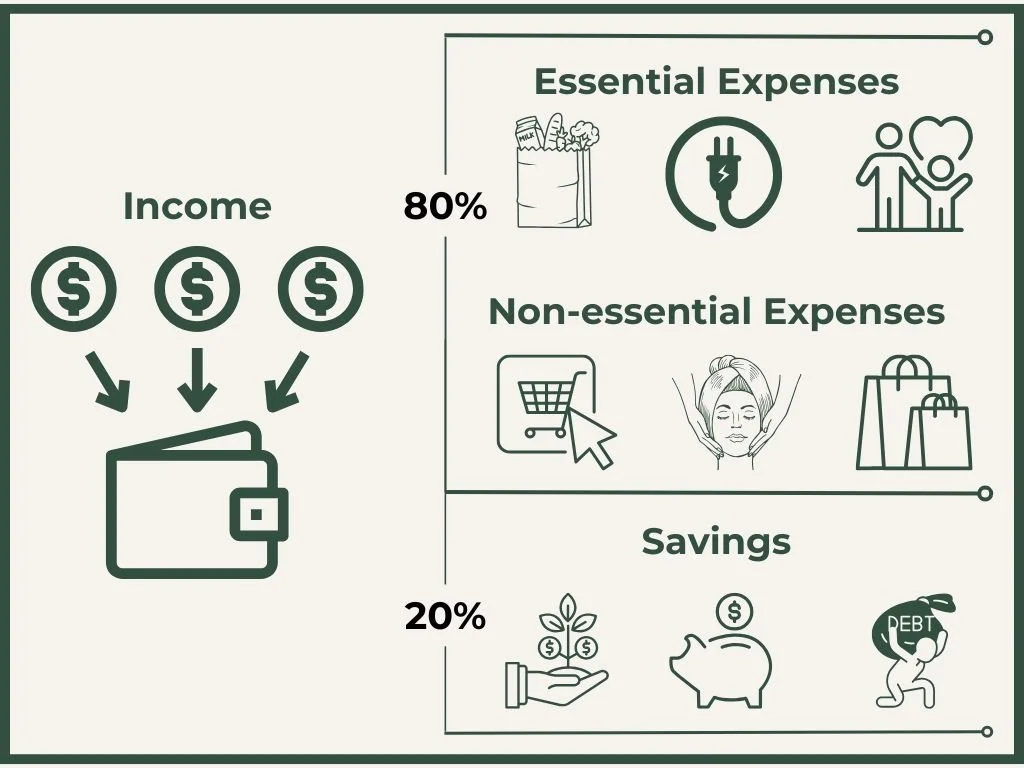Mastering the 80/20 Rule: A Simple Guide to Budgeting for Wealth and Freedom
The 80/20 rule is one of the simplest, most effective budgeting strategies you can follow.
It works like this: 80% of your income covers your operating expenses, like rent, groceries, utilities, and transportation, while the remaining 20% is dedicated to your financial goals. That 20% includes paying down debt, growing your savings, and investing. By following this rule, you ensure that your needs are met while still making progress toward financial independence and enjoying the present.
Understanding Your 80%: Essential & Non-essential Expenses
Essential expenses are your non-negotiables—think rent or mortgage payments, insurance, car loans, groceries, and other costs necessary to keep your life running. It’s important to prioritize these to ensure your basic living needs are fully covered before allocating money elsewhere.
Non-essential expenses, on the other hand, are more flexible. These include things like Amazon purchases, streaming subscriptions, clothing, and other discretionary spending that isn’t critical but still part of your everyday life.
Allocating the Remaining 20% of Your Income
Once you’ve covered your essential and non-essential expenses, the next step is deciding how to allocate the remaining 20%—your financial growth zone.
Tackling Bad Debt First: Your Biggest Wealth Killer
Carrying high-interest debt, especially from credit cards, is like dragging an anchor while trying to swim. The longer you hold onto it, the more money you waste on interest instead of using it to build wealth. Credit card debt, payday loans, and other high-interest liabilities can quickly snowball, making them a top priority for your 20% allocation. Once that’s under control, shift focus to your bigger savings goals—whether it’s a down payment on your dream home, a solid 3-6 month emergency fund, or a honeymoon/vacation fund to enjoy life without financial guilt.
Investing: The Power Move for Long-Term Wealth
Once you've tackled debt and built a financial cushion, it’s time to put your money to work. Investing is how you transition from simply managing money to growing it. Consider contributing to your 401(k) (especially if your employer offers a match), opening a Roth IRA, or dipping into index funds and ETFs for long-term, passive growth. If you want to diversify, real estate and high-yield savings accounts can also be solid options. The goal is to make your money work for you, so you’re not just relying on your paycheck to build wealth.
By following the 80/20 rule, you create a balance between financial responsibility and the freedom to enjoy your hard-earned money. Mastering this simple rule will set you up for a future of financial security, wealth, and the freedom to live life on your terms. To level up, setting up automated contributions ensures you consistently invest without overthinking it.
Next: The How-To Steps to Put this Plan into Action
Now that you understand the 80/20 rule, it's time to take action. Utilizing budgeting apps like Monarch, YNAB, or Mint can make tracking your expenses seamless and automated. If you prefer a more hands-on approach, creating your own budget using Excel or Google Sheets gives you full control over your financial planning. There are endless budgeting templates out there, and the best ones are simple to create, effective, and easy to follow. The most important step is to start—and if you’re looking for personalized guidance, there’s no better place to begin than with emPowers.

